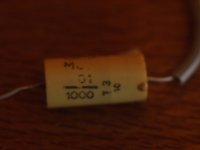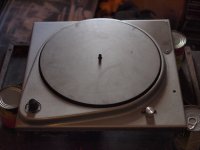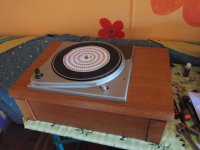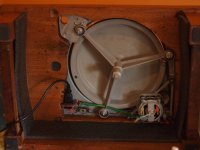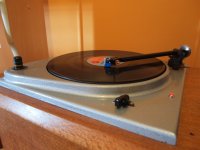Hi all
I'm in the process of restoring an old Orpheus turntable. Its a Transcription type running an ac motor (Australian power 230vlt 50hrz?).
It has a little noise reduction capacitor (well at least that's what I think it is, see photo) that Isn't working (allows power through, so motor runs on or off, see pdf for how it was wired).
If someone could tell me what to buy to replace it, that would be swell? Or is there a better more modern (SIMPLE) solution?
Any tips on grounding would be also appreciated. Should I ground the platter separate to the deck. Platter doesn't touch the deck except for nylon bushes.
Thanks any input will be appreciated. I've been using this forum and others to find lots of helpful info, but cant find any on this.
I'm in the process of restoring an old Orpheus turntable. Its a Transcription type running an ac motor (Australian power 230vlt 50hrz?).
It has a little noise reduction capacitor (well at least that's what I think it is, see photo) that Isn't working (allows power through, so motor runs on or off, see pdf for how it was wired).
If someone could tell me what to buy to replace it, that would be swell? Or is there a better more modern (SIMPLE) solution?
Any tips on grounding would be also appreciated. Should I ground the platter separate to the deck. Platter doesn't touch the deck except for nylon bushes.
Thanks any input will be appreciated. I've been using this forum and others to find lots of helpful info, but cant find any on this.
Attachments
Someone needs to confirm this is the correct type as I'm only 95% sure 🙂
EVOX RIFA|PME271Y510M|CAPACITOR, CLASS Y2, 0.01UF | element14 Australia
Looking at the PDF, maybe It's this one you need VISHAY BC COMPONENTS|BFC233810103|CAPACITOR, CLASS X1, 0.01UF, 440V | element14 Australia
I think you need the second one, but hopefully someone can confirm 😱
I don't see why there would be any need to ground the platter, at all 😕
EVOX RIFA|PME271Y510M|CAPACITOR, CLASS Y2, 0.01UF | element14 Australia
Looking at the PDF, maybe It's this one you need VISHAY BC COMPONENTS|BFC233810103|CAPACITOR, CLASS X1, 0.01UF, 440V | element14 Australia
I think you need the second one, but hopefully someone can confirm 😱
I don't see why there would be any need to ground the platter, at all 😕
Last edited:
Thanks mate. Reckon thats it, actually I have no idea, but I'll give it a go.
I'll see how the platter goes ungrounded, it was originally grounded to the deck, cant see the logic in that, but hey there's a lot I don't know about turntable, but I'm learning.
Thanks again much appreciated.
I'll see how the platter goes ungrounded, it was originally grounded to the deck, cant see the logic in that, but hey there's a lot I don't know about turntable, but I'm learning.
Thanks again much appreciated.
I'm just going on the PDF that denotes it as a "Class X" no doubt it is some sort of safety/suppression type of cap.
The platter was grounded?
Hmm...odd, to me anyhow, I guess if there is some sort of noise issue you can try grounding it.
The platter was grounded?
Hmm...odd, to me anyhow, I guess if there is some sort of noise issue you can try grounding it.
Last edited:
The capacitor is there to prevent sparking degrading the switch when turning off the inductive load (motor). If the motor now runs whether the switch is on or off then the cap has shorted, which a genuine mains-rated cap should never do. It may be that the original cap is a fake, or maybe it is not original but the result of an incompetent previous repair.
The usual problem with mains-rated caps is that they slowly reduce in value due to mains spikes burning little holes in the metalisation - they are designed to act in this way.
In this application any X or Y rated cap should do. The value is not too critical but don't stray too far from the original.
The usual problem with mains-rated caps is that they slowly reduce in value due to mains spikes burning little holes in the metalisation - they are designed to act in this way.
In this application any X or Y rated cap should do. The value is not too critical but don't stray too far from the original.
Data I stole the diagram from this pdf as it was easier than trying to draw one up myself.
Thank you for the explanation DF96, its likely I did something to the capacitor, maybe soldering too close .
So Data's second choice should do the job? Sorry just need to know what to get.
Thank you for the explanation DF96, its likely I did something to the capacitor, maybe soldering too close .
So Data's second choice should do the job? Sorry just need to know what to get.
Data I stole the diagram from this pdf as it was easier than trying to draw one up myself. .
http://www.okaya.com/images/noise/1100.pdf
Yeah, I would think that if that's the way it was connected as in the PDF, then it seems that the one stated in the PDF would be correct... "Class X"
Though is there any difference with a X1 and a X2 for example?
Found some useful info in these links ABC's of Safety (Interference Suppression) Capacitors for Tube Radios
Line-Filter
Though is there any difference with a X1 and a X2 for example?
Found some useful info in these links ABC's of Safety (Interference Suppression) Capacitors for Tube Radios
Line-Filter
Ta
I ended up getting the X1 as I could buy them singularly to make up the minimum $10 purchase. Quick delivery and the powers all sorted, no more pops when turning off.
Thanks mate.
I ended up getting the X1 as I could buy them singularly to make up the minimum $10 purchase. Quick delivery and the powers all sorted, no more pops when turning off.
Thanks mate.
- Status
- Not open for further replies.
- Home
- Source & Line
- Analogue Source
- Help with noise reduction capacitor on old turntable
